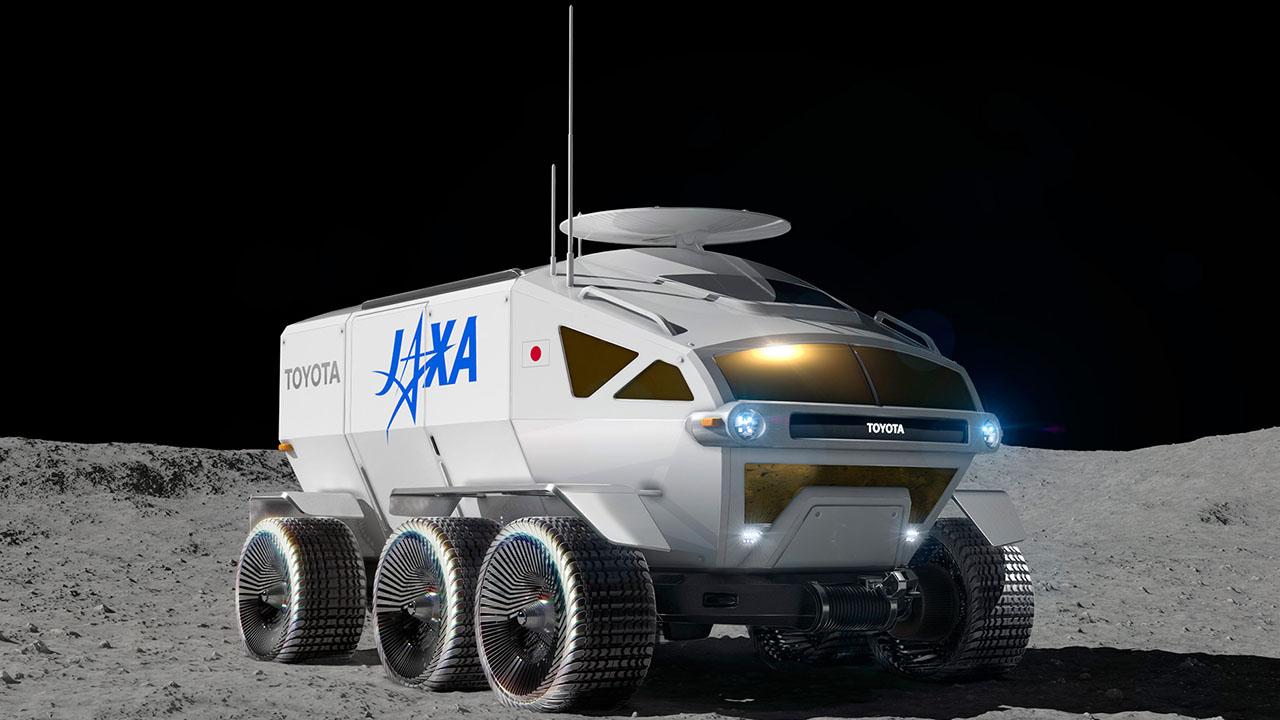
Toyota Times, having already discovered the intent behind developing the lunar rover at Tsukuba Space Center, now heads to the "Toyota Tokyo Design Laboratory" in Hachioji, Tokyo to find out about the current development status of the lunar rover.

In the first part of this article series, Toyota Times on his visit to the JAXA Tsukuba Space Center to learn more about a crewed lunar rover being jointly developed between JAXA and Toyota. Toyota Times visited both to take a tour and conduct interviews as part of his reporting. Following that, he then visited Toyota’s Tokyo Design Research Lab, in Hachioji City, Tokyo, hoping to see in person just how far development has actually progressed on the rover and speak with those involved.
The name came from that car
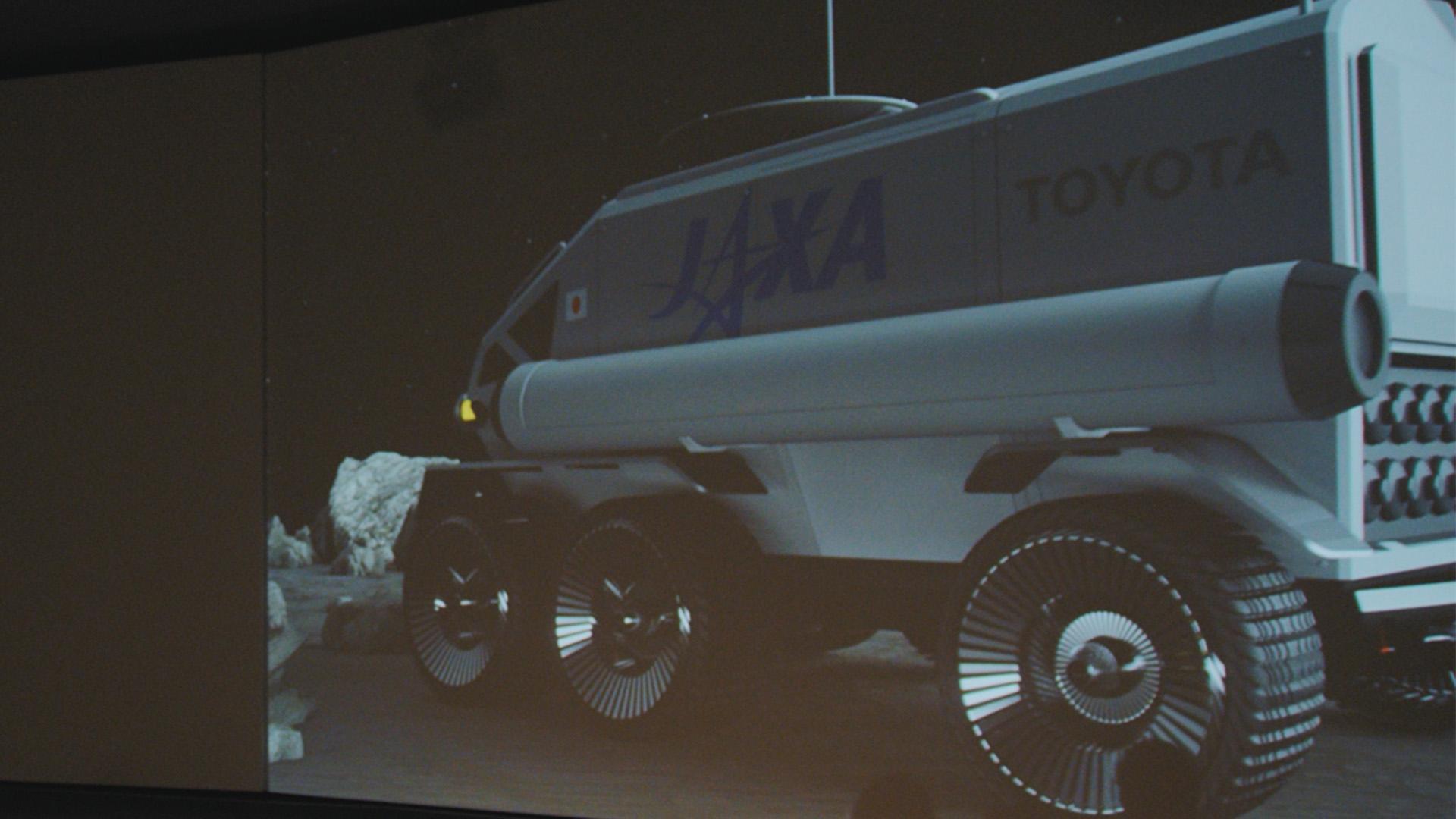
First at the Tokyo Design Research Lab, Toyota Times interviewed Mr. Hirofumi Inoue, development supervisor at the Advanced R&D and Engineering Company, and Mr. Takao Sato, project manager of lunar rover development at the Advanced R&D and Engineering Company.
Visible in a projected image onto a screen at the facility, Toyota Times was treated to see a full-scale lunar rover. Toyota Times, standing in front of the screen, shows just how huge the rover is – it was more than twice his height!
The fact is that there have been vehicles that have been driven on the Moon in the past. In the Apollo Program, for example, astronauts boarded a lunar vehicle called the LRV and actually drove around the Moon. However, the LRV was like a dune buggy, and the astronauts needed to continuously wear their spacesuits.
Unlike the buggy, the lunar rover under development by Toyota and JAXA is a more like a spaceship with tires. Once boarded and pressurized, the astronauts are expected to be able to survive inside, even without a spacesuit. For the upcoming missions, the aim is for two astronauts to be able to board and actually live in the rover for about 30 days while they explore the surface of the Moon.
This is a situation that humans have never experienced before, right?
Ohmura:
Because there is no air, the temperature in a given location can range from minus 170 degrees when in shade to 120 degrees in the sun, a difference that is unimaginable on Earth. Gravity is one-sixth of that here, and of course we have never driven cars in such low gravity. There is also the issue of exposure to radiation, so we can’t use rubber or resin parts.
Terashi:
This process, as I said before, of finding and solving various problems under various conditions is identical to how Toyota approaches work every day.
Toyota Times:
Have you given it a name?
Sato:
Toyota has a model called Land Cruiser, built on the concept of surviving through any conditions. We borrowed that name and called this the ‘LUNAR CRUISER’.
Virtual reproduction of the rover’s interior
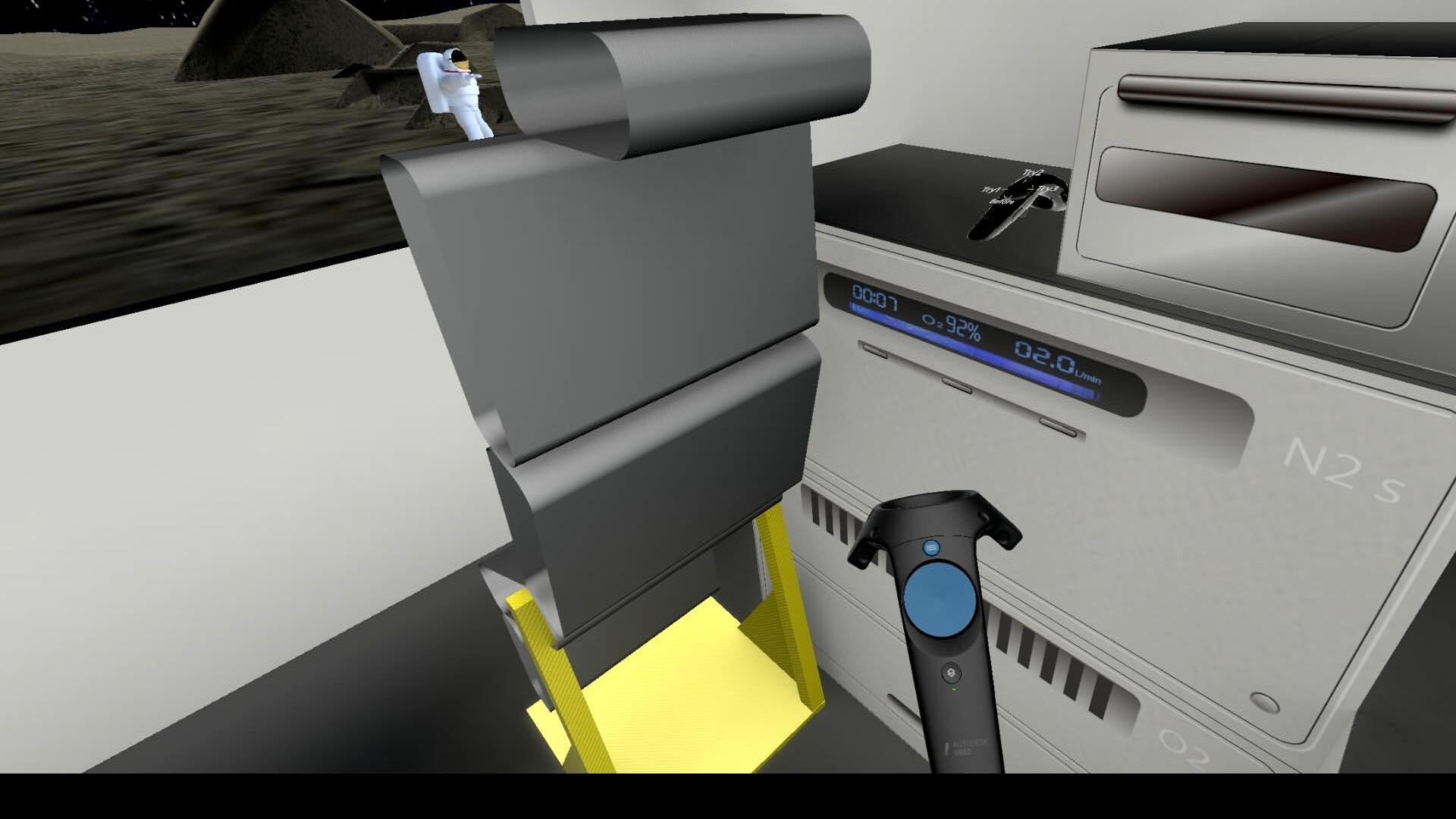
Eventually, the group moved to the room where the design work was being done for the Rover’s interior at the Tokyo Design Research Lab. Toyota Times’s guide at the lab was Mr. Toshikazu Tanemura, the person in charge of designing the interior living space for the rover at the Advanced R&D and Engineering Company Tokyo Design Research Lab.
To develop an interior space such as this, it is necessary to verify it in full scale, explains Tanemura. Since it costs a considerable amount of time and money to build the prototype room/space over and over again, Tanemura came up with a method of combining a simple physical model with a virtual model. By combining things this way, costs can be reduced or limited, as there is no need to continuously build an actual physical space. Additionally, reproducing the details using a digital platform allows for on-the-fly changes to the design as well as rendering to virtually test and verify many different possibilities related to the usability of the design.
These front windows, for example, we made them large to match the exterior but actually making something this large is difficult.
So we can change it to three smaller windows, for example. The rest is supplemented with monitor images. Even with small windows, we can still try to obtain a lot of visual information.。

Of course, once the actual exploration mission begins, the fact is that two humans will be living in a very narrow space within the lunar rover for an extended period of time. Considering this situation, among the guiding research themes the team focuses on, one centers on how to make extremely limited living space like the rover, with little room for freedom into a place where people can live happily, and thoughts towards what kind of space can support a relationship between two people.a
Our design members were speaking with astronauts, who let slip the comment, ‘that much we can endure’. That word ‘endure’ seemed to set an idea off amongst our team members.
Toyota Times:
Because they don’t want to be testing people’s endurance in there?
Inoue:
Correct.
Toyota Times:
So they want to provide comfort?
Inoue:
Yes.
Everything links back to the rover
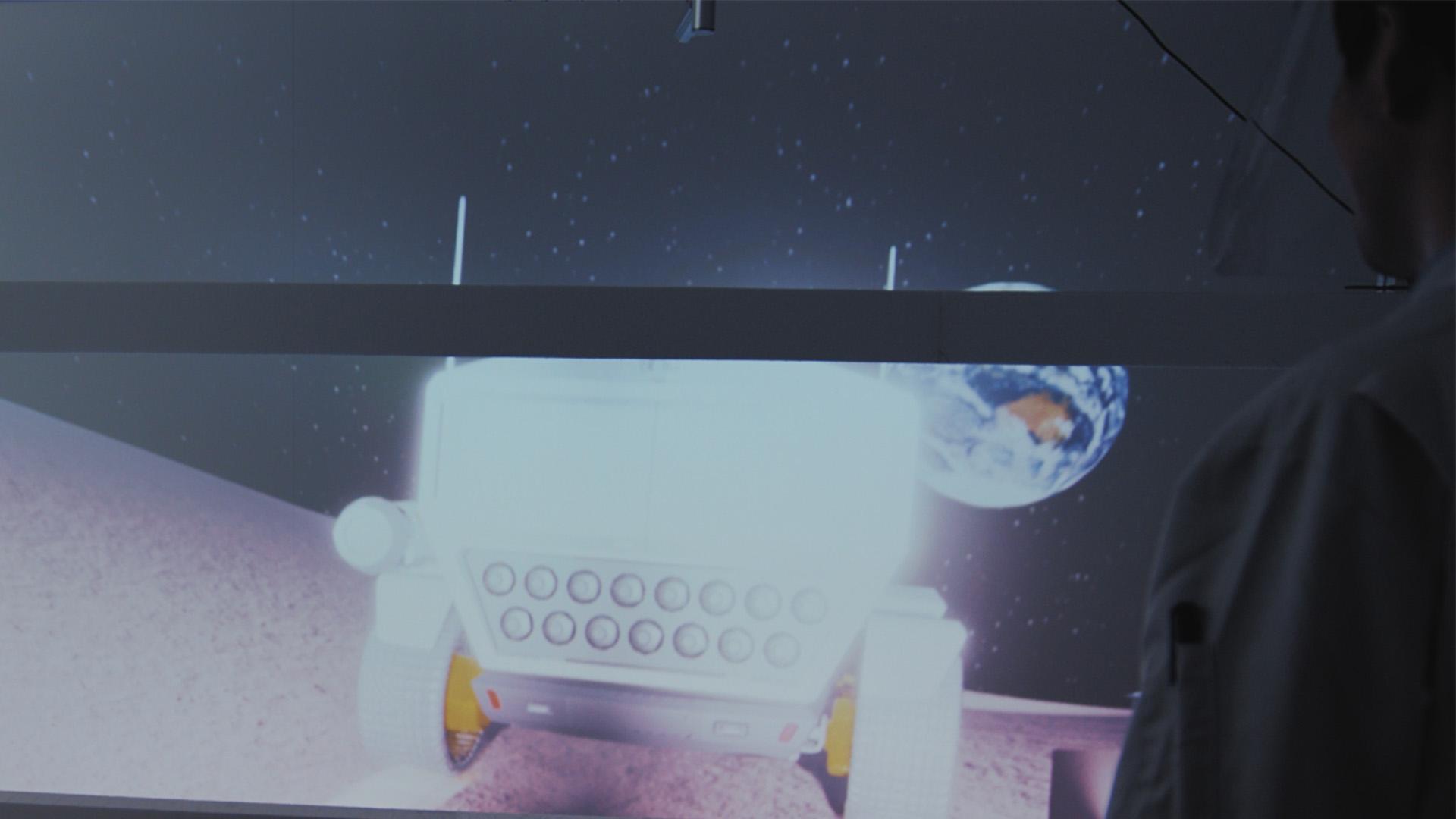
Next, Kohei Nakano from Prototype Department, the Production Engineering Development Center, brought the group to a room where there was a lunar rover automated driving simulator.
You should see blue square frames come up around the rocks, which indicate that the rocks have been properly detected.
Sato:
Because driving for 30 days straight would be extremely demanding, certain parts will be automated, with the astronauts taking over manually in cases when they need to try to escape a particularly difficult situation.
Toyota Times:
This is just like the Guardian system Toyota is currently promoting.
Sato:
Just like the Guardian, the automated driving is set up under the concept of partnering with the human driver to ensure safety.
Toyota Times:
But, you know, I feel like many aspects of the technology will then also be applied to regular cars back on Earth.
Sato:
I think so. We regard the Moon as one testing ground for our technology.
Mr. Shigeki Terashi, a director and executive officer of Toyota, shares the opinion that the lunar rover is an extension of the technology currently being developed for vehicles on Earth.
These are the technologies commonly referred to as C.A.S.E.
Trying to incorporate them all into the lunar rover is just the right challenge for us. We can’t make that leap without a hop, step and a jump, and this project allows us to raise our goals in various areas.
That’s right. We might have begun with the idea of a vehicle for traveling on the Moon’s surface, then we started looking at, for example, using hydrogen as a fuel. If the vehicle is to run on hydrogen, we need water to make that hydrogen. If the Moon’s surface contains water, we can use this to create a hydrogen society, which could lead to building cities. This idea embraces the same approach as Woven City; as we tackle many different aspects while moving forward, each one feels like a separate project, but I think that, beneath the surface, all of these pieces are actually linked together.
It will be the “Japan Rover,” not “Toyota’s Rover”
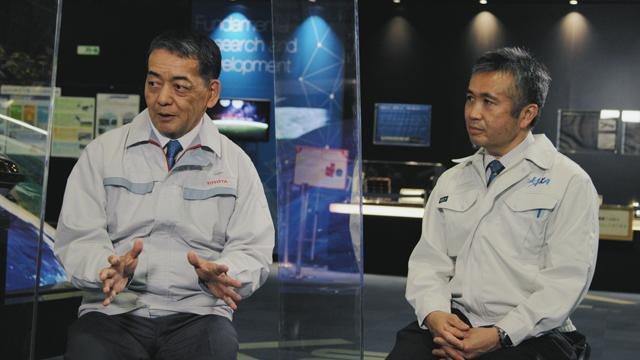
The lunar rover being developed was born out of collaboration starting between Toyota and JAXA, but Terashi thinks that it will eventually become the “Japan Rover” that will bring technologies of many Japanese companies together.
Will the rover have the Toyota emblem?
Terashi:
Well, President Toyoda has been saying this too, but in the past, Toyota was never very good at alliances or working with other companies; we were a company that just wanted to do every small thing ourselves.
Recently, however, with all the changes in the world, there are things that we can’t tackle singlehandedly, and we began shifting to work more with others. Right at that timing, we started this project from JAXA. So rather than calling this rover a Toyota vehicle, I think of it as Japan’s rover, because it is the culmination of technologies from various Japanese companies.

Naofumi Ikeda of the JAXA Human Spaceflight Technology Center Human Spaceflight Technology Department, and Junya Takeda of the Mitsubishi Heavy Industries Defense & Space Segment Space Division Engineering Department, Electronic Equipment Design Section, also emphasized such a “Team Japan” system.
How are you two involved in this project?
Takeda:
Our company is also involved in the space business, with diverse experience in space equipment, including Japanese rockets and the space stations Kibo and Kounotori. We hope to utilize our expertise in these areas to support JAXA and Toyota.
Inoue:
Using the framework of Team Japan, we have been joined by around 100 companies, which has allowed us to study the technology from various angles.
Tires are completely made of metal
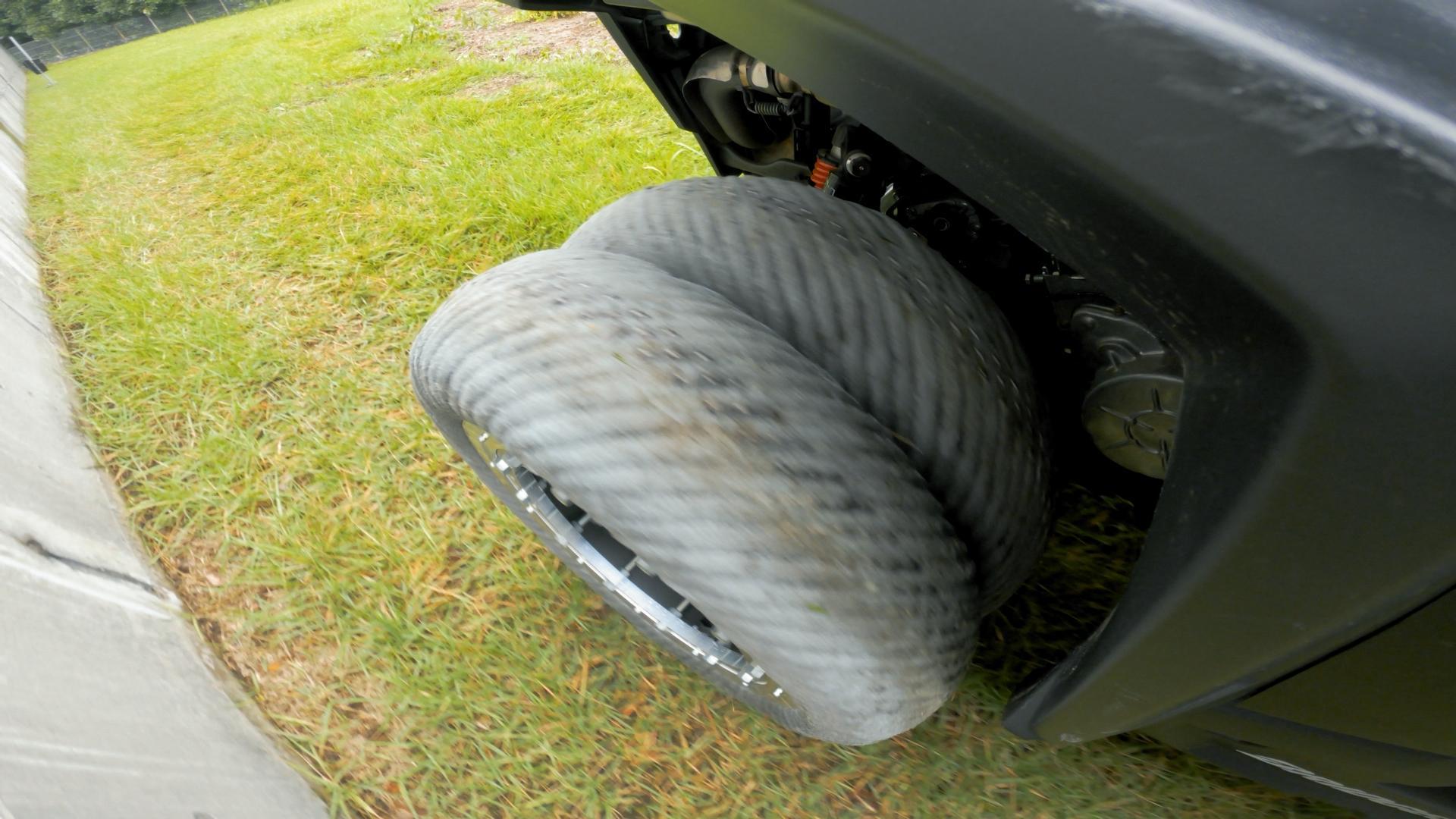
Bridgestone Corporation, an expert in the production of tires, has been placed in charge of the tires that will be used in the development of Team Japan's lunar rover. Yoshihide Kouno, Next Generation Technology Development Fellow, demonstrated a prototype of a lunar tire to the group. In the harsh environment of the Moon where the temperature is minus 170 degrees Celsius at night and there are high levels of radiation, rubber is completely useless. Therefore, Kouno and the Bridgestone team focused on using metal as the base of the tire. In fact, their team made a tire completely out of metal.
But things like radiation and extreme temperatures were not the only challenges facing this part of the rover’s development. The sand on the Moon is also exceptionally fine and smooth. This type of surface makes it extremely challenging when, for example, climbing a slope or rise. To solve this challenge, Kouno took a clue from the soles of the feet of camels that walk in the desert. The fluffy paddles of camels’ feet offered an idea for a tire specifically designed to run on the similarly sandy surface of the Moon.
With Kouno driving, Toyota Times took a test ride on a vehicle equipped with some prototype metal tires. Though they were completely metal, Toyota Times reported that the ride didn’t feel all that different from normal tires.
Toyota gave us incredibly strict performance requirements for these tires.
We’ve never been to the Moon, so how are we to know?

Following the ride, the discussion shifted to talking details about the project, specifically about the demands or requirements for the rover. Kouno laughs in the video as he tells Toyota Times about Toyota's demands being so tough, following which Toyota Times turns to Inoue, who is in charge of development, and Sato, the project director, about their actual pursuit in meeting these demands.
Earlier today, I was told from Bridgestone that Toyota’s requirements are very demanding.
Inoue:
That’s because the lunar environment is so harsh.
Toyota Times:
So you’re just passing on that message, as it were…
Inoue:
That’s right.
Sato:
As you can appreciate the challenge in front of us is extremely demanding. The most important thing in working together is to create a vehicle that is safe and reliable. We look at this project as more than simply building a piece of equipment – we want to create a vehicle in which people can place their trust.
Toward launching in 2029

Toyota and JAXA’s lunar rover is poised to launch in 2029. Will there actually be "LUNAR CRUISER" traversing the Moon only nine years from now? Terashi answered forcefully.
Will you make it by 2029?
Terashi:
We will.

